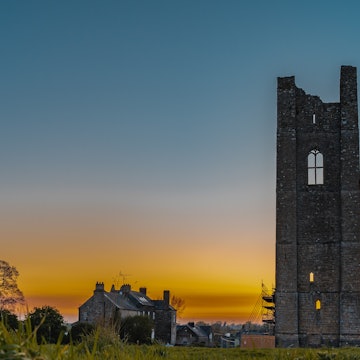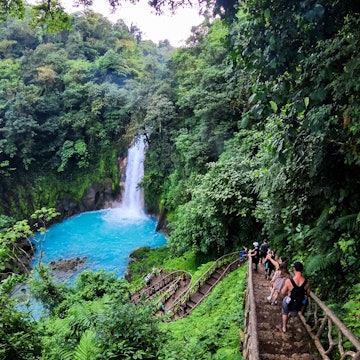

Given the number of travellers on the move these days, you might be forgiven for thinking that there is little left to discover. But in fact, our world remains full of fascinating, forgotten corners that the crowds are yet to, and may never, reach.
In this excerpt from Lonely Planet’s Secret Marvels of the World, four writers recount their experiences of such little-known yet astounding destinations.

Amy Balfour visits the Racetrack Playa, California
As my Jeep Liberty slammed over the washboard ruts of Racetrack Road in Death Valley National Park, I tried to keep my bones from rattling right out of my body. With miles of washboard ahead and empty desert all around, I felt vulnerable and alone. But then again, that was the point.
My goal? Observing the mysterious moving rocks of the Racetrack Playa, a dry lake-bed in the northern wilds of the park. I was living in Los Angeles at the time, trying to break in as a screenwriter. But success was elusive. As a goal-oriented person, I decided to tackle a series of challenging outdoor adventures. Mini-successes would keep me fired up.
But then I met Racetrack Road. A 20-mile unpaved nightmare in a desert valley flanked by dark mountains. How nightmarish? The park recommends 4WD. A spare tyre is also smart. Cell phone coverage? Nope. And did I mention that Charles Manson and his followers holed up in the southern reaches of Death Valley after the Helter Skelter murders? Misfits and malcontents were no strangers here.

Teakettle Junction finally appeared, a solitary mileage marker typically draped in tea kettles. The playa was six miles ahead. Anticipation overtook fear as I drove. After reaching the south-playa parking area, I left the Jeep. Approached the lakebed.
Boulders dotted the parched earth before me. In their wake, trails were carved into the dirt. How did the rocks move? Some weighed more than 600 pounds. That question had bedevilled observers for decades. Aliens? Supernatural forces? Freakish weather? Scientists solved the mystery in 2013. In winter, a thin sheet of ice occasionally covers the playa. As the ice warms, it cracks apart. Winds push these ice patches into rocks that have tumbled from surrounding mountains. The wind-driven ice floes shove the rocks across the slick lake-bed. After temperatures rise, the ice vaporises, leaving the boulders.
I walked, took pictures. Mesmerising. But I had a long journey back, so I didn’t linger. My return? Bumpy, but fun. I’d accomplished my goal. Even better? I’d seen something rare, which triggered a sense of lightness and wonder. Maybe there was magic left in the world. And though the mystery has since been solved, the stark beauty of the setting and the rarity of the phenomenon keep the place amazing.
The boulders dot the southern end of the playa. Don’t walk across the playa when it is wet; don’t drive or cycle across it at any time. The western border of the park is 370km from LA.

Joe Bindloss visits Haw Par Villa, Singapore
When Hercules made his journey to the underworld to dognap the demon pooch Cerberus, he had to wrestle ghosts and monsters. Visiting the underworld in Singapore was a little bit easier. All I had to do was jump off the Mass Rapid Transport train, stroll across Pasir Panjang Road, and step into the bowels of hell…
Haw Par Villa, a sculpture garden created by eccentric brothers Aw Boon Haw and Aw Boon Par (best known for inventing Tiger Balm), ranks as one of the world’s most surreal tourist attractions. Sprawling over 3.2 hectares of prime Singapore real estate, and coated in untold gallons of primary-colour gloss paint, are more than a thousand statues of demons and deities from Chinese and Buddhist mythology. Many are arranged in gruesome dioramas of torture as a warning to anyone thinking of carrying out evil deeds in this lifetime.
I had encountered some wacky visions of the afterlife on my travels – Hieronymus Bosch’s nightmares at Madrid’s Museo del Prado, the concrete pumpkin-from-hell in Laos’ Xieng Khuan Buddha Park – but Haw Par Villa held a special appeal. I think it was the hallucinogenic colours in the pictures I’d seen before visiting. Having been raised on Hendrix and Tom Wolfe’s The Electric Kool-Aid Acid Test, seeing psychedelia in three living dimensions was much too alluring to resist.
Stepping through the innocent-looking Chinese gates, I was nevertheless unprepared for the nightmarish whimsy that was on display on the winding walkways. What was that? A crab with a man’s head. And there? A girl with a snail’s body. Nearby, the damned writhed in agony as they were crushed beneath grindstones and impaled on spikes, drenched in red-paint gore as if part of an early Hammer horror film.
The lack of attendants and general scarcity of visitors – a situation which has bought the gardens close to closure on several occasions – only added to the sense of being transported into a freakish parallel universe.
In fact, it’s not all doom and gloom here. For every sawing demon, there’s an uplifting scene of Buddhist meditation or a magnificent Chinese dragon as large as a subway train. For the lay person, it’s a mesmerising introduction to the rainbow world of Chinese and Buddhist mythology, and despite the patchy signage, the symbology – do bad deeds, get speared by devils – transcends the language divide.
The sculpture park is open daily from 9am to 7pm. MRT trains run regularly to Haw Par Villa station.

Gregor Clark visits Stromboli, Italy
Sitting astride the volcanic arc between Italy’s Mt Vesuvius and Sicily’s Mt Etna, the hyperactive re-breathing island of Stromboli has captured human imaginations for eons. Ancient sailors dubbed it ‘lighthouse of the Mediterranean’ for its constant eruptions, and the volcano-lover in me had long felt drawn to this perfect cone floating in isolation at the Aeolian archipelago’s eastern edge. So, on a sunny mid-May afternoon, with a full moon forecast, I cruised over for a visit. My small group set off at 4.30pm from San Vincenzo church. A steady climb through yellow broom and wild capers brought us above the tree line, revealing bird’s eye views of whitewashed Stromboli village and the sparkling Mediterranean. Above us, a zigzag line of fellow hikers slogged summit-wards across bare ashen expanses.
Two hours later, we emerged into the otherworldly landscape of Stromboli’s summit: smoking craters juxtaposed against a ruddy twilight sky, with the setting sun and its reflection tracing a giant upside-down exclamation mark across the sea. For the next 60 minutes, bundled against the cold, we enjoyed front-row views of the volcano’s fireworks. From our exhilarating vantage point above the craters, we gazed in wonder at the steadily hissing steam, punctuated at unpredictable intervals by vertical jets of fire, thunderous explosions and the pitter-patter of sizzling rocks rolling down the craters’ flanks. As the skies darkened, the eruptions morphed from red-freckled billows of grey smoke to vivid fountains of red-orange light – each unique, all beautiful.

What goes up must come down. Eventually our headlamp-clad crew stepped single-file on to the talus-strewn wasteland of Stromboli’s eastern slope and began our steep descent, with the moonlit sea spread out at our feet, stretching to the twinkling lights of Italy’s mainland.
Once was not enough. The mountain had gotten under my skin, and I felt compelled to linger. At dusk the next night I hopped on a boat to observe the eruptions from the sea, and before sunrise the following morning I hiked up to the Sciara del Fuoco, the desolate grey expanse below Stromboli’s craters where you can watch molten rocks careen down the slopes and crash into the Mediterranean 900m below. A decade later, I’m as obsessed as ever; I’ve returned almost every year since, and Stromboli’s magic still hasn’t worn thin.
Access Stromboli by daily hydrofoil from Milazzo (Sicily) or twice-weekly ferry from Naples. The summit's off-limits to under-7s.

Ray Bartlett visits Hashima, Japan
As the boat leaves Nagasaki Port, heading for the ‘Ghost Island’ of Hashima, I’m finding it hard to keep calm. I keep scanning the horizon for the unmistakable ship-like silhouette that gives the place its nickname: Battleship Island. We leave the shoreline, passing boats, barges, and uninhabited small islands, then someone calls: ‘There it is!’ Sure enough, just like a naval warship, the island seems to float on the surface of the water, faded yet unmistakeable against the azure sky.
Visiting Hashima had been on my bucket list for years, first while living in Japan in the ’90s, then later again as photos of this wasteland cityscape began to surface in popular culture. Most famously, it was used as the villain’s lair in the 2012 James Bond film, Skyfall.
Ironically, Hashima, owned by a coal company, was once the most densely populated place in Japan. When the coal mine closed in 1974, however, it took only four months for the island to be abandoned. Its dormitories, equipment, schools, clinics, and temples were all left behind like something out of a post-apocalyptic dream. Now buildings have sloughed away, revealing forgotten dolls, televisions, and kitchen appliances.
Vine-choked alleyways are strewn with rubble from the evocative, artful decay. As we arrive and clamber out onto walkways, I feel like I’m being escorted into a world of science fiction. Rusted iron spikes are twisted into claw-like fingers. The mine shaft seems like a gaping mouth. I blink and see ghosts of miners coming up from the depths, blackened from head to toe.

We stop at a safe distance away from the structures, in case of sudden collapses. The group, a chatty bunch of mainly Japanese tourists, has fallen silent, sombre. I imagine spending a night on the island, watching as the sun soaks the cement. It’s impressively bleak, devoid of not just human life, but any life at all. I’m hard-pressed to spot even a seagull wheeling around in the sky.
As we return to the boat, I think of the Inca, the Maya, the Anasazi, the Egyptian Pharoahs. Will Tokyo and New York and Paris look like this someday? Who lived here? People will wonder, as they pass along marked paths. What caused them to leave? Where did they go? When the boat finally docks, the throngs of people around me seem more precious, and more fragile. It’s a feeling that takes a long time to fade.
Access is only via guided tour from Nagasaki’s port; tours leave once or twice daily. See gunkanjima-concierge.com.
http://shop.lonelyplanet.com/world/secret-marvels-of-the-world-1/













